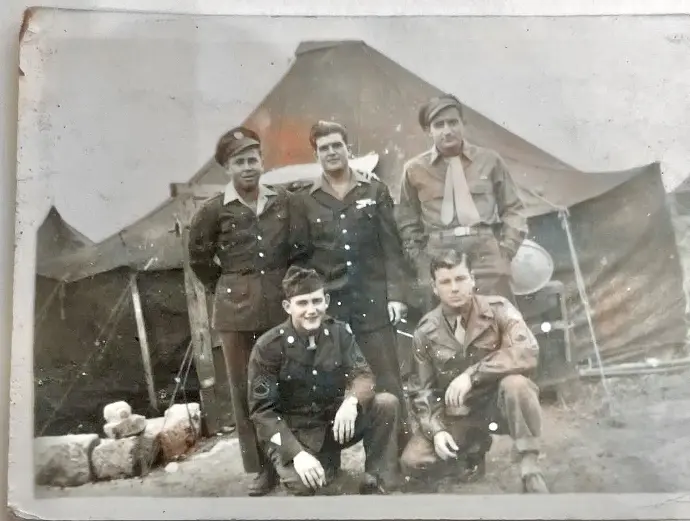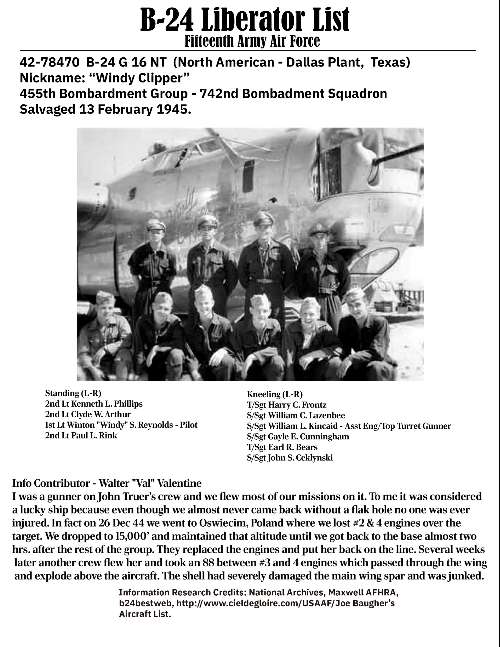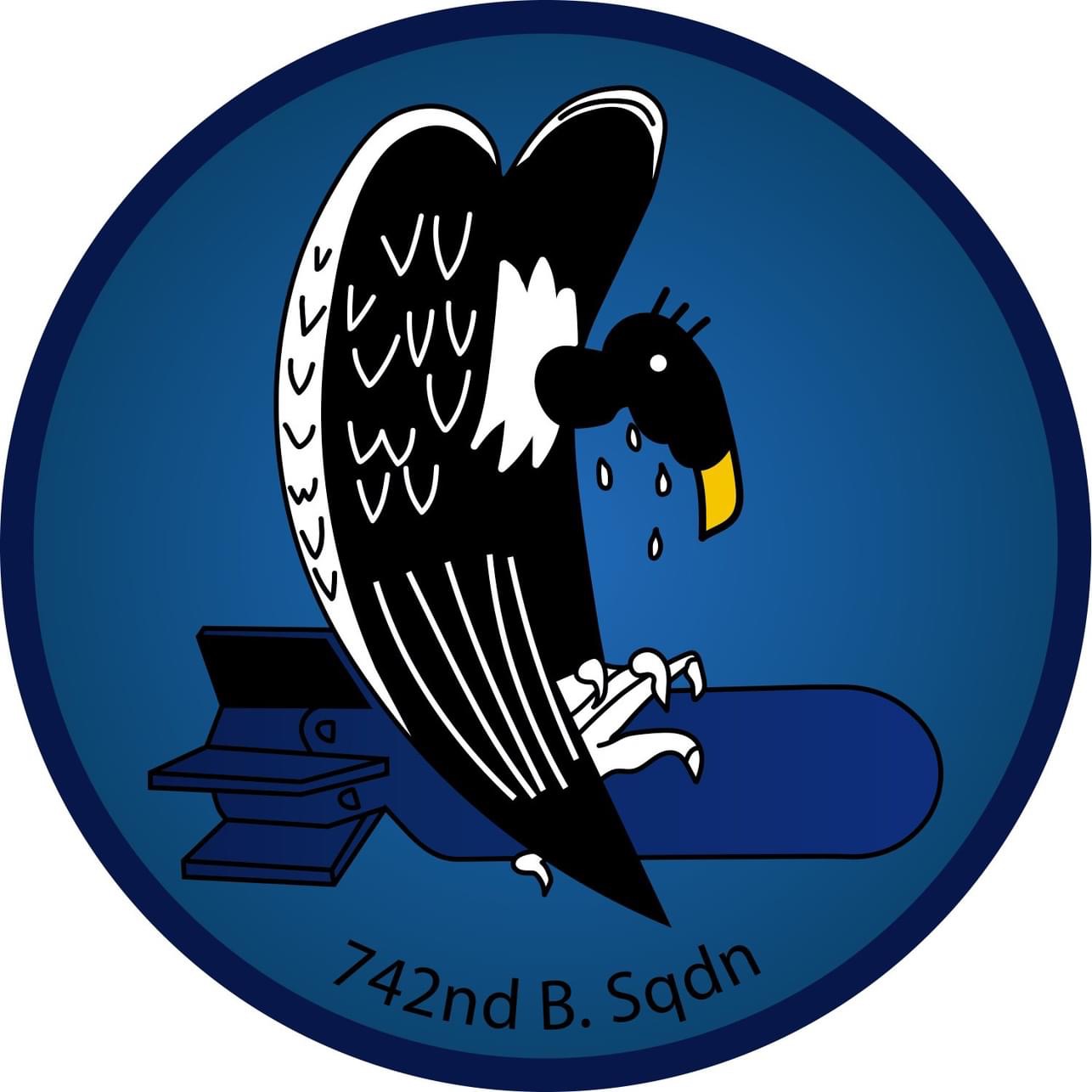Lazenby Military
WILLIAM C. LAZENBY
World War II
B-24 Liberator Aerial Gunner
15th AF, 304th Bomb Wing,
455th Bomb Group ("Vulgar Vultures"), 742nd Bomb Squadron
San Giovanni, Italy
Bill Lazenby
B-24 Liberator
San Giovanni Airfield, Italy
1944
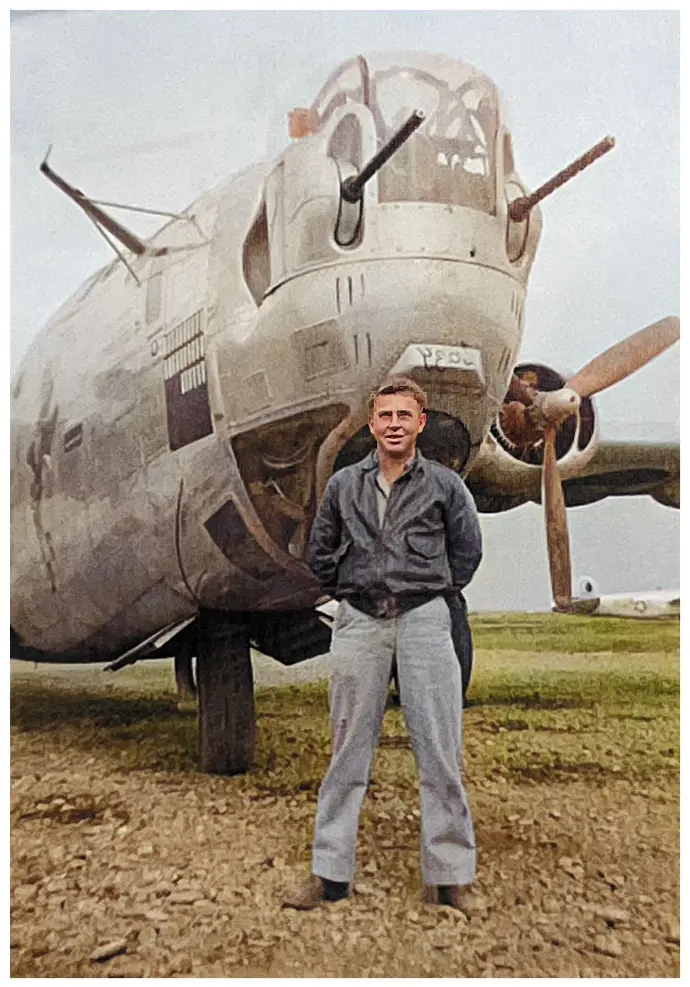
Right: San Giovanni Airfield
Below: Map of 15th Air Force airfields around Foggia, Italy
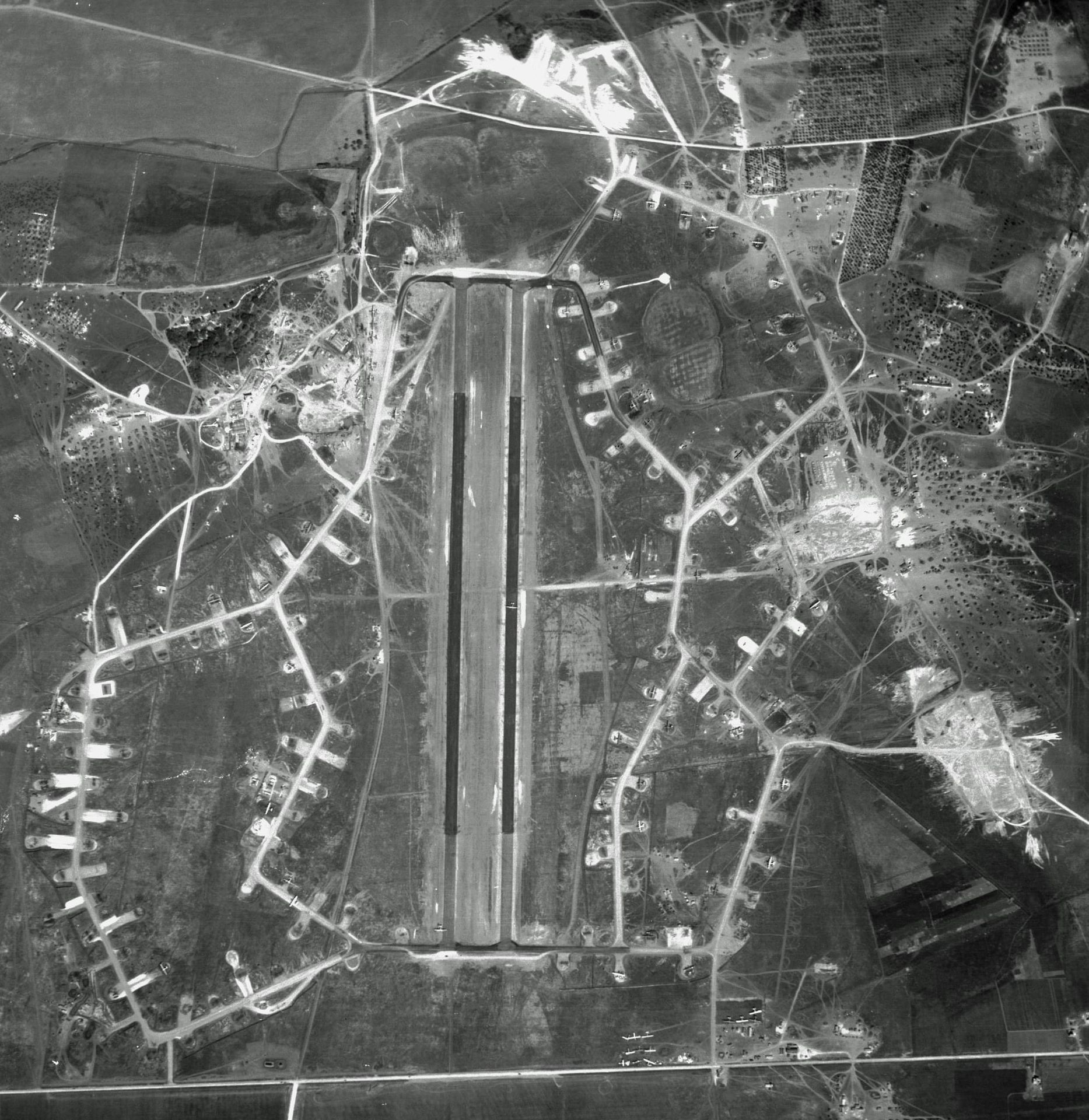
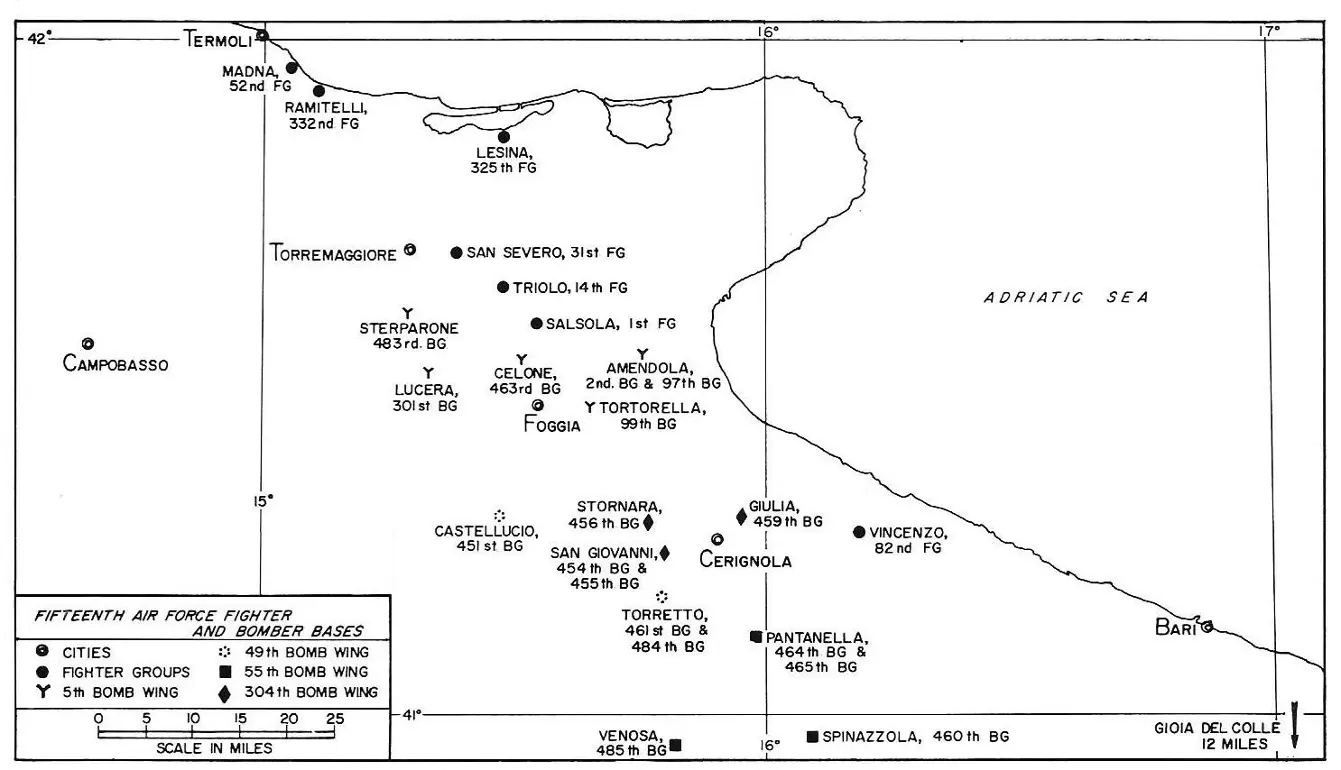
Assignments/Orders:
- Apr 8, 1943 - Date of enlistment
- Aug 27, 1943 - Keesler Field, MS - Basic training and then technical school (B-24 maintenance)
- Feb 8, 1944 - Laredo, TX - Aerial gunnery school
- May 22, 1944 - Gowen Field, Boise, ID Training for 455th Bomb Group as part of 2nd AF (training)
- Jun 29, 1944 - From Gowen Field, Boise, ID to Topeka, KS (Attached to: 2nd AF, 21st Command, 272nd SB) - Aircrew training
- Jul 15, 1944 - Transfer from Gander Field, Maine to APO 520 (15th AF, 304th Bomb Wing, 455th Bomb Group, 742nd Bomb Squadron)
- Jul 12, 1944 - Departed for overseas
- Jul 20, 1944 - Arrived overseas; See the story here how the crew flew together from US to Italy)
- First mission documented was Jul 25, 1944 from San Giovanni, Italy
- Aug 1, 1944 - Detailed to 742nd BS (while in Italy)
- Nov 1, 1944 - Detailed to 742nd BS (while in Italy)
- Jan 15, 1945 - Left overseas
- Jan 25, 1945 - Arrived back in US
- I believe he went to P-47 mechanics school at 127th Army Air Force Base
- Sep 9, 1945 - Honorable Discharge
Organization:
- 15th Air Force
- 304th Bomb Wing
- 455th Bombardment Group (Heavy) - Vulgar Vultures
- 742nd Bomb Squadron - list of airplanes
- Airplanes he flew with, including primary plane 470. Number (Mission number):
- 470 (1, 2, 3, 4, 6, 7, 8, 10, 11, 12, 13, 15, 16, 18, Dry Run, 20, 21)
- 938 (Dry Run)
- 310 (5, 9, 17)
- 332 (14)
- 624 (19, 25)
- 636 (22, 30, unnumbered Dec 9, 31, 34, 35)
- 201 (23)
- 151 (24)
- 775 (26, 33)
- 935 (27)
- 010 (29, 32)
- B-24 Liberator Gunner - #42-78470 "Windy Clipper" (better pic here). This plane was salvaged Feb 1945
- Story about Windy Clipper
- Air Crew normally stayed together for all of the missions
- LT Winton "Windy" S. Reynolds - Pilot
- LT Kenneth L. Phillips - CoPilot
- LT Paul T. Rink
- LT Clyde W. Arthur
- T/Sgt Harry C. Frontz
- T/Sgt Earl R. Bears
- S/Sgt William L. Kincaid - Asst Engineer/Top Turret Gunner
- S/Sgt Gayle R. Cunningham
- S/Sgt William C. Lazenby
- S/Sgt John S. Ceklinski
- B-24 School -
- AIRPLANE MECHANIC-GUNNER (748)
- Aerial Engineer-Gunner
- Assists pilot in operation of a multiple-engined airplane by maintaining a constant check on its mechanical functioning.Fires aerial guns in combat.
- Notes readings of engine and navigation instruments, reporting any indication of malfunctioning, and maintains log of engine performance.
- Makes limited repairs and mechanical adjustments while in flight.
- Transfers fuel from one tank to another as consumed, in such manner as to maintain balance of airplane, Assists pilot in deciding whether airplane should be grounded when serious malfunctioning develops, Reports needed repairs to maintenance crew.
- Base Location: San Giovanni Airfield in Italy
- Roll Call 455th - Click here - Lazenby, William C on Page 21
- Certificate of Valor for 35 missions in B-24 airplane as a mechanic-gunner - commended for efficiency
- Air Medals:
- Medal - August 18, 1944
- 1st Oak Leaf Cluster - Sep 5, 1944
- 2nd Oak Leaf Cluster - Nov 17, 1944
- 3rd Oak Leaf Cluster - Jan 2, 1945
- Campaign Medals
- European-African-Middle Eastern Bronze Battle Participant (45 Bronze Stars)
- Stars for Italian and Southern France Campaigns
- Newspaper article on Jan 27, 1945
- SGT LAZENBY HOME AFTER FIFTY AIR MISSIONS
- The Review-Appeal is in receipt or the following interesting account regarding S/Sgt William C. Lazenby, who is now visiting his parents, Mr. and Mrs. Will Lazenby, after spending eight months overseas:
- FIFTEENTH ARMY AIR FORCE - S/Sgt. William C. Lazenby, 20, Brentwood, Tenn., serving as a nose gunner with a B-24 Liberator bomber group of the 15th Army Air force in Italy has completed his fiftieth mission over enemy held targets in Europe, and is the proud possessor of the Air Medal with three Bronze Oak Leaf Clusters, awarded him "for meritorious achievement in aerial flight while participating in sustained operational activities against the enemy." Sgt. Lazenby's third mission was over Budapest. He believes that this was the toughest of his combat experience. The Group which the sergeant was flying with was attacked by 40-50 enemy fighters. Sgt. Lazenby's plane had its entire hydraulic system shot away and the tires of the aircraft completely destroyed. It was only with a great deal of skill that the plane landed at its home base. On another mission over Avigon, France, the plane which Sgt. Lazenby was flying had its tires shot away, and on his 45th mission which was over Blechhammer, Germany, his plane ran into difficulties. After dropping their bombs on the assigned target the Group headed for home. They ran into a severe storm. Ice was piling up on the wings and stabilizers so fats it could not be broken off. Trouble developed in number four engine which necessitated it being feathered. The plane was in great difficulty. During the struggle against the storm and the long weary ride to the target the supply of gas was running low. They were directly over the Adriatic Sea. They knew they couldn't make it back to their base. The men were standing by, their nerves tense, waiting that dreaded order to bail out. The foam capped waves of the angry sea was beneath them. They were alone, lost from their foundation. The pilot, 1st Lieut, Winton B. Reynolds, 10515 Fontenelle Way, Los Angeles, Cal., was using all of the skill of his training to keep the plane in the air as long as possible. The navigator of the ship advised the pilot that they were in the neighborhood of Vis, a small island in the Adriatic Sea. After circling around in the stormy skies the island was discovered and the plane made a crash landing onit. In the meantime number one and two engines had developed trouble and cut-out. The plane landed with only one engine operative, and the gas tanks practically empty. The pilot brought the plane down without serious injury to any member of the crew members. Asked how he felt about his fifty missions, the sergeant replied, "Every airman dreams about reaching the half century mark. I'm glad I made it. I would like to go home and see my folks, but am willing to finish another fifty if it's necessary and will help get this was over with." A graduate of Central High School, the sergeant was a former employee of N. C. & St. L. railroad, Nashville, Tenn.
Special Achievements
Campaigns
Other Links
Missions
The anatomy of an air combat mission was done very well by the 392nd BG. Although a different organization, the same process applies to all bomb groups.
- Missions Bomb Group (BG)
- The following listings are the 35 missions listed in his record.
- The 455th Bomb Group (BG) Mission number is listed first.
- Second I listed the actual field order where Lazenby is found. Click on the underlined text to bring up the field order.
- He is listed under 742nd Bombardment Squadron, then by plane (ship) number. He normally flew with LT Reynolds.
- The last Mission number is the after action summary of the mission.
- BG Mission #84: Mission 1 7/25/44 - Ship 470 Linz, Austria (Hermann Goering tank works)
- Mission 84, July 25 Twenty-five B- 24's loaded with 1,000# GP bombs were briefed to bomb the Hermann Goering Tank Works at Linz, Austria. Flak at the target was very heavy and intense, and many of the planes received damage. One aircraft was so badly shot up that the crew was forced to abandon their plane. Fortunately, they parachuted over friendly territory and all were safe and returned to base though somewhat later than the rest of the crews.
- BG Mission #85: Mission 2 7/27/44 - Ship 470 Budapest, Hungary (Manfréd Weiss Armament)
- Mission 85, July 27 We were briefed to bomb the marshalling yards and the Manfred Weiss Armament Works at Budapest, Hungary. Twenty eight B-24's loaded with 500# incendiary bombs were the last group in the Wing formation. Not only was the target obscured by smoke but the fighters were waiting for us as well as the usual flak. We were attacked by as many as 90 enemy fighters and they were very aggressive. We had a running battle for over 30 minutes. We lost five planes in the battle and 51 crewmen were missing in action, one of our biggest losses to date. We claimed 17 enemy fighters shot down with 14 probables. Seven of our planes received serious damage from flak and fighters, and two more suffered slight damage.
- Mission #87: Mission x - 7/31/44 - Ship 938 Dry Run ((Mogosoaia, Romania oil storage)
- Mission 87, July 31 We had a whole weekend of rest, and on Monday we sent 25 B-24's loaded with 500# RDX bombs to the Oil Storage area at Mogosaia near Bucharest. The target area was well covered by bombs as we bombed by visual methods for a change. Flak was very heavy in the target area and many planes received damage. One of the planes had its hydraulic system shot out and ended up over the hill at the end of our run way, "totaled."
- JULY (ending) - July ended our sixth month of combat with some impressive numbers. We flew 17 missions with 525 planes over the target. We dropped a total of 1,110 tons of bombs and shot down 20 enemy aircraft with 16 probables. We lost 23 aircraft and 121 crewmen missing in action. We also lost three crewmen killed in action and many more wounded. This was a rough month of combat for the Group.
- AUGUST (beginning) - The start of the month of August promised a lot of good flying weather. That meant more and longer missions. Longer daylight hours didn't mean the ground crews wouldn't work longer hours, they worked long enough hours as it was, it just meant that they would be able to work in the daylight. The object of our missions had not changed. It was still oil, oil, and more oil! Along with that, we would be asked to help in the invasion of southern France. On the 3rd of August we began our seventh month of combat.
- BG Mission #88: Mission 3 - 8/3/44 - Ship 470 Friedrichshafen, Germany (Lowenthal A/C Factory)
- Mission 88, August 3 We loaded 34 B-24's with 500# GP bombs to bomb the Zahnrad-Fabric Works in Friedrichshafen, Germany. Fabric here means metal fabrication, not cloth. The flak was not heavy but was very accurate and we lost one plane which was last seen dropping back over the Alps with ten crewmen missing in action. Results of the bombing could not be seen due to cloud-cover at the target.
- BG Mission #90: Mission 4 - 8/7/44 - Ship 470 Blechhammer, Germany (synthetic oil refinery)
- Mission 90, August 7 Twenty-eight B-24's loaded with 500# GP bombs took off to bomb the Blechhammer South Synthetic Oil Refinery at Glewitz, Germany. This was one of our longest missions to date and our longest into Germany. We ran into very little flak and no fighter opposition. What flak we encountered severely damaged two of our planes. The target was smoke-covered but we managed to bomb it successfully. Smoke was also seen at Budapest as we passed on the way back to base. All planes returned to base safely.
- BG Mission #92: Mission 5 - 8/12/44 - Ship 310 Coastal Guns France
- Mission 92, August 12 We were briefed for a slightly different target for this day as we bombed gun positions in southern France along the coast. This signaled the start of another ground offensive. It was an easy mission as we encountered no opposition either from flak or fighters. All planes returned safely.
- BG Mission #94: Mission 6 - 8/14/44 - Ship 470 Savona, Italy (gun positions)
- Mission 94, August 14 The targets that we received from the Wing and Air Force indicated that more is afoot than they will let on. We were to bomb gun emplacements in Southern France. We sent 30 B-24's loaded with 1,000# GP bombs. The flak at the target was moderate and accurate but we came through without any casualties, only one plane had slight damage.
- BG Mission #95: Mission 7 - 8/15/44 - Ship 470 Coastal Guns France (Beach No. 263c)
- Mission 95, August 15 The Group experienced its first take-off and assembly at night. We assembled 25 B-24's carrying 100# GP bombs to attack beach position 263C in southern France. As we assembled we saw explosions from crashing 24's and 17's from other groups. Our hearts were beating much faster this night as we knew the invasion was on in southern France and we were all a part of it. Those who flew this mission will never forget the sight of all those Allied ships approaching the coast and the terrific bombardment that hit the coastline. We dropped our bombs and came back to base to await the news of the invasion.
- BG Mission #97: Mission 8 - 8/18/44 - Ship 470 Campina, Romania (Steaua Romana oil refinery)
- Mission 97, August 18 We were back to Rumania again. This time we had as our target the Romano Oil Refinery at Steaua. We encountered flak en route to the target as well as in the target area. It varied from light to intense. We dropped our 500# bombs and returned to base with only one air craft damaged by flak. No fighters were observed.
- BG Mission #98: Mission 9 - 8/20/44 - Ship 310 Dubrova, Czechoslovakia (oil refinery)
- Mission 98, August 20 This was our third mission in a row on oil refineries. This time it was the refinery at Dubova, Czechoslovakia. Of the 30 B-24's we sent, only 21 dropped their bombs as "C" box was not able to line up on the target. As a result, they returned to base with their bombs. Flak at the target was light and not very accurate. All planes returned to base without any casualties.
- BG Mission #99: Mission 10 - 8/21/44 - Ship 470 Hadju Roscorment, Hungary
- Mission 99, August 21 We were sent to bomb the airdrome at Hadju Roscorment, Hungary. Thirty B-24's loaded with fragmentation bombs took off but only 20 were able to bomb as the "C" box leader could not get his bomb bay doors open. These aircraft jettisoned their bombs over the Adriatic. No flak at the target nor fighters were seen, so it was a relatively easy mission.
- BG Mission #101: Mission 11 - 8/23/44 - Ship 470 Ferrara, Italy (railroad bridge)
- Mission 101, August 23 Twenty-six B-24's were briefed to bomb the railroad bridge at Ferrara, Italy. Planes were loaded with 1,000# GP bombs and we dropped 87 tons near the bridge. No hits were observed but the target must have been important as the flak was heavy, intense and accurate. We suf fered damage to ten aircraft. Tw-o air craft landed at different bases as they could not make it back to home base.
- BG Mission #102: Mission 12 - 8/24/44 - Ship 470 Kolin, Germany (oil refinery)
- Mission 102, August 24 Twenty seven B-24's loaded with 500# RDX bombs attacked the Vacuum Oil Refinery at Kolin, Czechoslovakia. Bombing was accomplished visually with many bombs falling in the target area. There was no flak at the target and no enemy fighters were encoun tered. All planes returned to base safe ly, an easy mission for a change.
- BG Mission #103: Mission 13 - 8/26/44 - Ship 470 Bucharest, Romania
- Mission 103, August 26 We were scheduled for the last time to the Ploesti area, this time to bomb the German barracks at the Baneasa Airdrome. Thirty B-24's loaded with 100# GP bombs hit the assigned target. This mission was the day following the "100th Mission Bash" and many of the men were a little under the weather but they responded as always. Flak at the target was nonexistent but flak was encountered along the route. Fighters attacked a straggler and we saw several chutes from that plane. We also lost the lead crew from the 743rd Squadron along with the Deputy Group Commander, Col. Hugh Graff, with 21 crewmen missing in action. It was later reported that 10,000 German troops were killed and numerous enemy air craft destroyed by the 15th Air Force that day.
- BG Mission #104: Mission 14 - 8/27/44 - Ship 332 Blechhammer, Germany (synthetic oil refinery)
- Mission 104, August 27 Another long mission to Blechhammer, Germany, these were long, usually very rough and were always over seven and one-half hours in duration. That was tough on all crewmen and their support crews back at the base. This day we sent 28 B-24's loaded with 500# GP bombs. They bombed with good results but as usual the flak was very heavy and intense over the target. We lost another plane. It was last seen with one engine feathered losing altitude off to the left of the formation. Ten crewmen were reported missing in action.
- BG Mission #105: Mission 15 - 8/28/44 - Ship 470 Ora, Italy (Avisa Viaduct northern Italy)
- Mission 105, August 28 We sent 31 B-24's to bomb the railroad bridges in northern Italy. Our assigned bridges were at Avisio and Pescheria. Their destruction was to disrupt the German retreat but we did not do a very good job. Only one bridge was identified and we missed that one. One aircraft was severely damaged by flak but all returned safely.
- SEPTEMBER 1944 (beginning) - With winter coming, there were changes made in mission planning to avoid reduced activity because of bad weather. The formations of our B-24's would become smaller and thus more manageable in marginal weather. Some bombing strikes were single airplanes flying in bad weather and bombing by pathfinder. Pathfinder methods were used to a good advantage during bad weather months, continually disrupting the enemy's capability to wage war. In September, the German Air Force fighters disappeared from the sky as far as the 455th was concerned. If they were there, we did not see them. We continued with our attacks on the enemy's oil production and their air craft industry. The war against oil was not over yet, as this month would prove, although one big target was eliminated from our list, Ploesti. Our targets would be the enemy's communication lines as well as his factories. We hit the marshalling yards and ports, along with the oil refineries.
- BG Mission #108: Mission 16 - 9/2/44 - Ship 470 Nis, Yugoslavia (west and south M/Y)
- Mission 108, September 2 Thirty B-24's took off to bomb the marshalling yards at Nis, Yugoslavia. No aircraft returned early so that all planes dropped a total of 75 tons of 500# GP bombs on the target. Flak was light and not very accurate. All aircraft returned to base without incident.
- BG Mission #110: Mission 17 - 9/4/44 - Ship 310 Taguamente/Casaesa (railroad bridge)
- Mission 110, September 4 Thirty one B-24's loaded with 1,000# GP bombs were after bridges again. This time it was the railroad bridge at Tagliamento, Italy. The results were even better this time, with almost 60% falling into the 1,000 feet circular range. There was no flak at the target and all aircraft returned safely.
- BG Mission #112: Mission 18 - 9/6/44 Ship 470 Novi Sad, M/Y Yugoslavia (M/Y)
- Mission 112, September 6 We had excellent weather and had flown six missions in as many days. The marshalling yards at Novi Sad, Yugoslavia were the target for the second time this week. Thirty B-24's loaded with 1,000# ROX bombs hit the target with over 75% of the bombs falling within 1,000 feet of the aiming point, which was remarkable bombing. Flak at the target was moderate and accurate but we came home with no casualties.
- BG Mission #115: Mission -- - 9/12/44 - Ship 470 Dry Run - Scheduled to fly but scratched with E/R written in orders.
- BG Mission #116: Mission 19 - 9/13/44 - Ship 624 Ordetal, Germany (O/R)
- Mission 116, September 13 We loaded 30 B-24's with 500# RDX bombs to bomb the oil refinery at Odertal, Germany. This was another long mis sion. We bombed the target by pathfinder and dropped 68 tons of bombs. Flak at the target was moderate to intense and very accurate. We lost three ships over the target. One pilot brought his plane back to Allied territory and the crew bailed out successfully. Nineteen crewmen were missing in action.
- BG MIssion #117: Mission 20 - 9/17/44 - Ship 470 Rakos M/Y, Budapest, Hungary
- Mission 118 (should be 117), September 17 We sent 27 B-24's loaded with 1,000# GP bombs to the marshalling yards at Rakos, Hungary. The results were not satisfactory as we had no bombs within the 1,000 foot range. Flak was moder ate at the target but we had no losses.
- BG Mission #119: Mission 21 - 9/18/44 - Ship 470 Czegleo M/Y
- Mission 119, September 18 We loaded 29 B-24's with 500# RDX bombs to bomb the marshalling yards at Czegleo, Czechoslovakia. We encountered no flak en route nor at the target area but we still did not do a good bombing job as only 26% fell within 1,000 feet of the aiming point. All planes returned to base without casualties
- OCTOBER 1944: October brought bad weather for the first three days. Although missions were scheduled, none were flown until the 4th of the month. While we still were hitting oil refineries, we also concen trated on the marshal1ing yards that transported the oil. Oil refineries would only be 23% of our missions this month while over 60% would be against mar shalling yards. Missions from here on would be effected by weather as much as anything else.
- BG Mission #125: Mission 22 - 10/4/44 - Ship 636 Avisio River Viaduct, Italy
- Mission 125, October 4 While one portion of the Group was bombing Munich, the Group also sent 17 B-24's to bomb the viaduct at Avisio, Italy. These planes were loaded with 1,000# RDX bombs. No results were observed due to cloud-cover. Flak at the target was moderately accurate and heavy. Six aircraft received damage from the flak but all returned safely.
- BG Mission #136: Mission 23 - 10/20/44 - Ship 201 Innsbruck M/Y, Austria
- Mission 136, October 20 We sent 33 B-24's carrying fragmentation bombs to the marshalling yards at Innsbruck, Austria. Flak at this target was moderate and inaccurate, and we escaped without any damage. All planes returned to base.
- BG Mission #139: Mission 24 - 10/23/44 - Ship 151 Ossopo
- Mission 139, October 23 We load ed 16 more B-24's with 100# GP bombs for the second mission of the day. They were scheduled to bomb the Motor Transport Park at Ossopo. Weather again made the target unreachable and all planes brought their bombs back to base.
- OCTOBER (ending) October was a month that saw bad weather affect our efforts. We flew 16 missions in only 13 days of flyable weather. The coming months look the same as far as weather is concerned. We managed to put 425 aircraft over the targets. We dropped over 793 tons of bombs on the enemy. We lost five aircraft from enemy action with 52 crew men missing in action. We had one man killed in action and one man wounded.
- NOVEMBER (beginning): NOVEMBER 1944 Winter time brought on weather problems that not only hindered bombing efforts, but also maintenance and other ground support functions. This month would be a harbinger of what to expect in the next four or five months: bad weather, bad weather and more bad weather. But the Group would nevertheless fly almost 20 missions. Four of these would be aborted and nine would bomb by pathfinder method. Still it was remarkable for the Group to take off on that many missions; a real credit to the support personnel and crews.
- BG Mission #143: Mission 25 - 11/5/44 - Ship 624 Vienna/Florisdorf, Austria
- Mission 143, November 5 Twenty eight B-24's took off to bomb the Florisdorf Oil Refinery at Vienna, Austria. Half of the B-24's carried 500# RDX bombs while the other half carried 500# incendiary bomb clusters. Bombing was done by pathfinder method so no results were observed. Flak at the target was intense, inaccurate and heavy. Flak en route was moderate and fairly accurate at Bratislavia. All aircraft returned to base safely.
- BG Mission #146: Mission 26 - 11/7/44 - Ship 775 Sjnicia T/C, Yugoslavia
- Mission 146, November 7 Twenty eight B-24's attacked troop concentrations at Sjenica, Yugoslavia. They dropped 66.5 tons of RDX bombs on the target. Flak at the target was non-exis tent. Bombing was done visually with fair to poor results. All aircraft returned to base.
- BG Mission #147: Mission 27 - 11/11/44 - Ship 935 Linz, Austria (orders had Graz/Wetzeldorf, Austria)
- Mission 147, November 11 The Group was scheduled to bomb the marshalling yards at Linz, Austria. All 28 B- 24's returned to base without dropping their bombs due to bad weather.
- BG Mission #148: Mission 28 - 11/15/44 - Ship 010 (Prior return at 1249 T/O at 0905) Linz PR, Austria
- Mission 148, November 15 Five B- 24's took off to bomb the Linz Benzol Refinery. All five aircraft bombed the target by pathfinder method and returned safely despite the intense flak at the target. None of the aircraft received any damage.
- BG Mission #151: Mission 29 - 11/17/44 - Ship 360 Blechhammer, Germany or Gyor, Hungary (confusing as report and orders for location do not agree) Mission 152 actually went to Gyor. Lazenby was listed on Missi9on 151.
- Mission 151, November 17 Eighteen B-24's took off to bomb the marshalling yards at Mirabor, Hungary. Flak at the target was very intense and accurate, and one aircraft was shot down by flak. One crew member was killed by flak and three others received serious injuries. Bombing results were good with over 40% of the bombs falling within 1,000 feet of the aiming point. 1\velve men were missing in action
- BG Mission #153: Mission 30 - 11/18/44 - Ship 636 Vincenza A/D, Italy
- Mission 153, November 18 Forty B-24's loaded with 500# RDX bombs were briefed to bomb the Airdrome at Vicenza, Italy. The mission was flown without escort and bombing was done visually with excellent results. Over 50% of the bombs fell in the target area causing extensive damage to the installation. Flak at the target was light and generally inaccurate. All planes returned to base without casualties
- BG Mission #157: Mission 31 - 11/22/44 - Ship 636 Munich, Germany or Plan Able or Villach, Austria
- Mission 157, November 22 Thirty six B-24's took off to bomb the marshalling yards at Villach, Austria. No flak was observed in the target area and no bombs were dropped because of bad weather but we still lost one aircraft, with 11 men missing in action. The B-24 was last seen losing altitude and appeared to be on fire. No chutes were observed. The rest of the planes returned safely.
- His crew flew Ship 010 to Munich, GE on 11/25/44 but he was not listed as a crew member.
- BG Mission #163: Mission ## - 12/9/44 - 636 Linz, Austria (this mission not listed in his official records)
- Mission 163, December 9 Fifteen B-24's loaded with 500# RDX bombs struck the industrial area of Linz, Austria by pathfinder method. They reported that they had a good run on the target. Flak at the target was mod erate and inaccurate. No observations were made due to the cloud-cover. All planes returned to base.
- BG Mission #164: Mission 32 - 12/12/44 - Ship 010 Niese A/D, Germany
- Mission 164, December 12 Four B-24's equipped with pathfinder equipment took off to bomb the oil refinery at Blechhammer, Germany without escort. Two of the aircraft bombed the primary target as briefed. The other two bombed a target of opportunity at Neisse, Germany by pathfinder methods. One of the bombs dropped at the primary target was a leaflet bomb and in falling, it shattered the ball housing the pathfinder equipment. Three aircraft returned to base and one made a forced landing at the island of Vis.
- BG Mission #167: Mission 33 - 12/17/44 - Ship 775 Odertal, Germany
- Mission 167, December 17 Thirty six B-24's took off to bomb the oil refinery at Odertal, Germany. Two airplanes returned early due to gas leaks while 31 dropped their bombs by pathfinder method. Sixty-six tons of 500# RDX bombs were dropped on the primary target. Three aircraft dropped their bombs on other targets since the flight leader was out of position on the bomb run. Flak at the target was moderate and generally inaccurate. One of our aircraft was lost and was last seen about 5,000 feet below the formation with an engine on fire. No chutes were observed and ten crewmen were missing in action. All other·planes returned safely.
- BG Mission #168: Mission 34 - 12/18/44 - Ship 636 - Supron (order showed bombing Osweicim, Poland)
- Mission 168, December 18 Thirty-Mission 168, December 18 Thirty-seven B-24's took off to bomb targets in Germany. Three aircraft returned early and 31 dropped 74.5 tons of 500# RDX bombs on a target of opportunity, the marshalling yards at Sopron. The bombing was accomplished by pathfinder method. No flak was experi enced in the target area or en route to the target. All planes returned to base safely.
- BG Mission #172: Mission 35 - 12/27/44 - Ship 636 - Graz M/Y, Austria
- Mission 172, December 27 The weather was giving us a break and we were able to get three days in a row with favorable flying weather. We had 31 B- 24's take off and bomb the main marshalling yards at Graz, Austria. The Group dropped 62.5 tons of 500# RDX bombs on the target with fair results as 35% of them fell within 1,000 feet of the aiming point. Slight to moderate flak was experienced at the target. All aircraft returned to base with no casualties.
- DECEMBER 1944 (ending) The month of December was over as far as missions were concerned. It was a month that saw the Group fly several different kinds of missions with two and three single planes as well as many pathfinder missions. The Group flew a total of 16 missions with 359 aircraft over the targets. These aircraft dropped a total of 649.5 tons of bombs. We lost 15 aircraft with only four due to flak and the other 11 due to other causes. There were 111 crewmen reported missing in action and 32 reported killed in action. December was not a good month in that regard. We were looking forward to the new year as one that would end the conflict.
- JANUARY 1945 (beginning) January started off just like one would expect in this climate: cold, snow and rain. The outlook for continued operations was not good. The Group had to see what developed from day to day. Most of the targets were communications targets as these were closer and gave us a chance to hit them before the weather changed. Briefings would continue in the off chance that the weather would break and the Group could fly. This was the month when the Wing and Group started designating dual missions and Blue and Red Forces.
